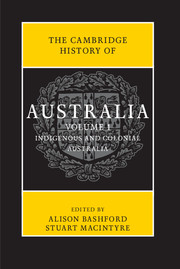Book contents
- Frontmatter
- Contents
- Abbreviations
- List of maps
- List of figures
- List of tables
- Notes on contributors
- Map
- Preface
- Introduction
- PART I
- PART II
- Further reading
- Chronology
- Index
- Frontmatter
- Contents
- Abbreviations
- List of maps
- List of figures
- List of tables
- Notes on contributors
- Map
- Preface
- Introduction
- PART I
- 1 Nation building, 1901–14
- 2 The Great War and its aftermath, 1914–22
- 3 Search for a solution, 1923–39
- 4 World War 2 and post-war reconstruction, 1939–49
- 5 The Menzies era, 1950–66
- 6 Instability, 1966–82
- 7 Growth resumed, 1983–2000
- 8 The new millennium
- PART II
- Further reading
- Chronology
- Index
3 - Search for a solution, 1923–39
from PART I
Published online by Cambridge University Press: 05 November 2013
- Frontmatter
- Contents
- Abbreviations
- List of maps
- List of figures
- List of tables
- Notes on contributors
- Map
- Preface
- Introduction
- PART I
- PART II
- Further reading
- Chronology
- Index
- Frontmatter
- Contents
- Abbreviations
- List of maps
- List of figures
- List of tables
- Notes on contributors
- Map
- Preface
- Introduction
- PART I
- 1 Nation building, 1901–14
- 2 The Great War and its aftermath, 1914–22
- 3 Search for a solution, 1923–39
- 4 World War 2 and post-war reconstruction, 1939–49
- 5 The Menzies era, 1950–66
- 6 Instability, 1966–82
- 7 Growth resumed, 1983–2000
- 8 The new millennium
- PART II
- Further reading
- Chronology
- Index
Summary
In 1923 a Gallipoli veteran, not yet 40 years old, replaced a London-born man more than 20 years his senior as prime minister. The change might have been a mark of the times – the Anzacs coming into their own, in a nation their gallant deeds had made. But the new prime minister, Stanley Melbourne Bruce, was not an Anzac. He had been wounded at Gallipoli, but as a captain in a British regiment. And although born in the city after which he was named, the Cambridge-educated Bruce had spent nearly all his adult life in Britain.
Bruce was an Anglo-Australian. He would not have seen his enlistment in a British regiment in preference to the Australian Imperial Force (AIF) as an act of disloyalty or arrogance. Neither would most Australians of his time. In his imperial patriotism Bruce had much in common with most men of the First AIF. Bruce walked with a limp, a result of wartime injuries; this legacy was something else shared with other Australian men of his generation. The war exacted great costs long after 1918. Apart from returned men's suffering, there was the burden endured by wives and children, often amid official neglect. Many died prematurely, while some found themselves unable to earn a living as their health declined. Others battled on, and did their best to forget the horror. A few, such as Major General H.E. ‘Pompey’ Elliott, who had wept over Fromelles, killed themselves.
Many of those on the non-Labor side of politics previously willing to work with William Morris (‘Billy’) Hughes became more hostile to his leadership in the years following the war. The watershed December 1922 election delivered the balance of power to the new Country Party under Dr Earle Page. It would not support Hughes who, despite his abandonment of the Labor Party in 1916, had retained its taste for high levels of state intervention in the economy. Bruce – Hughes' treasurer and a political novice – was elevated to the prime ministership and oversaw the formation of a coalition between the Nationalists and Country Party.
- Type
- Chapter
- Information
- The Cambridge History of Australia , pp. 64 - 87Publisher: Cambridge University PressPrint publication year: 2013
- 3
- Cited by

